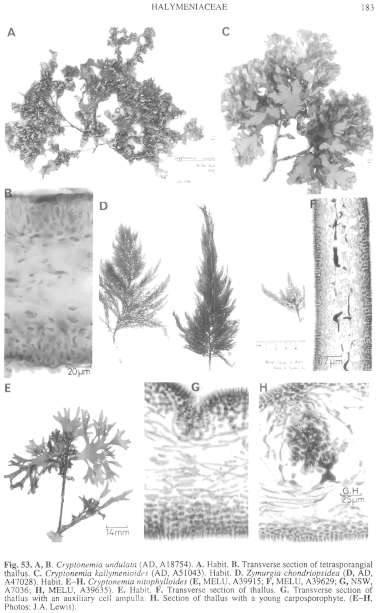|
|
|
|
|
|||||||||||
|
Electronic Flora of South Australia Species Fact Sheet
Phylum Rhodophyta – Class Florideophyceae – Order Gigartinales – Family Halymeniaceae
Synonym
Kallymenia nitophylloides J. Agardh. 1885: 33; 1892: 69. De Toni 1897: 302. Lucas 1909: 26. May 1965: 405. Millar & Kraft 1993: 21. Womersley & Norris 1971: 41, fig. 106.
Thallus (Fig. 53E) pinkish-red to dark red-brown, 2–5.5 cm high, firm to cartilaginous, sometimes with distinct, concentric, widely spaced whitish bands across the breadth of the fronds; fronds arising from a simple or branched, cartilaginous stipe (Fig. 53E), complanately branched, subdichotomous to irregular, branches flat, mostly 2–4 mm broad above, 8–10 mm broad below divisions, axils rounded, apices acute to rounded, sometimes proliferous when damaged. Stalk terete, 0.5–6 cm long, 1–2 mm in diameter, often extending into blades up to 8 mm as a raised, evanescent midrib. Holdfast discoid, 2–8 mm across; epilithic. Structure. Blades (Fig. 53F, G) 100–130 µm thick; medulla filamentous, 50–65 µm thick, the filaments longitudinally aligned near branch apices, becoming less regularly aligned, but remaining mostly periclinal below; refractive ganglioid cells (Fig. 53F) present; cortex of branched anticlinal files of 4–5 cells (Fig. 53G), the inner cells rounded, 5–6 µm in diameter, becoming outwardly smaller, the surface cells elongate, tapering, (5–) 7.5–10 µm long and 2–3 µm in diameter at the base.
Reproduction: Sexual thalli dioecious. Carpogonial branch ampullae not seen. Auxiliary cell ampullae (Fig. 53G) extending into the medulla, the auxiliary cell being the fifth or sixth cell of a curved primary ampullary filament arising from an inner cortical cell, cells of the primary filament bearing sparingly branched secondary filaments which converge towards the surface and divide subdichotomously into short chains of cells close to the thallus surface. After presumed fertilization the auxiliary cell cuts off a gonimoblast initial toward the thallus surface which in turn cuts off gonimoblast filaments (Fig. 53H); cells of the ampulla filaments to the sides and base of the gonimoblast elongate to form a slight involucre and continue to proliferate near the thallus surface; mature gonimoblast 120–150 µm across and 85–125 µm high, with several distinct gonimolobes, swelling the thallus to 230–275 µm thick; ostiole absent. Cystocarps often in sorus-like aggregations near branch apices but they also occur scattered over the thallus surface. Male gametophytes with ovoid spermatangia, 2–2.5 µm in diameter and 4–5 µm long, cut off from the outer cortical cells over the thallus surface.
Type from the mouth of the Richmond River, N.S.W. (Hodgkinson); lectotype in Herb. Agardh, LD, 24800; isotypes in Herb. Agardh, 24801, 24802 and MEL, 501417.
Selected specimens: The lectotype and isotypes. Point Lonsdale, Vic., 2–3 m deep under heavily shaded overhang on Lighthouse Reef (Kraft, 14.ii.1977; MELU, A39631-A39638; AD, A54151; van Amerongen, 16.ii.1990; MELU, A38235; Kraft & Saunders, 27.ii.1992; MELU, A39893, A39915, A39916). Queenscliff, Vic., 15 m deep off Shortlands Bluff (La Ferla, 26.ii.1989; MELU, A39639, A39640). Sydney Harbour, N.S.W., 17 m deep on large round grazed boulders west of North Head (Millar & Richards, 21.ii.1990; NSW, A7717, A7719); 18 m deep on sandstone boulders at base of South Head (Millar & Richards, 19.i.1990; NSW, A7034, A7036). Muttonbird I., Coifs Harbour, N.S.W., 5 m deep on sand-covered rock (Millar & Huisman, 8.vii.1981; MELU, A39623, A39630); 12 m deep (Millar & Gabrielson, 16.viii.1982; MELU, A39621, A39622, A39624–39629).
Distribution: South-eastern Australia, from Port Phillip Heads, Vic., to the mouth of the Richmond River, northern New South Wales.
Taxonomic notes: Tetrasporophytes isomorphic with gametophytes; tetrasporangia scattered, attached basally or sub-basally to inner cortical cells, 18–23 µm long and 12–15 µm in diameter, cruciately or decussately divided.
Until recently, this species was known only from Miss Nina Hodgkinson's type collection of Kallymenia nitophylloides J. Agardh from the mouth of the Richmond River in northern New South Wales, which Womersley & Norris (1971, p. 41) recognised as probably belonging to the Halymeniaceae. It has now been found subtidally at a number of locations in south-eastern Australia and examination of these specimens has shown the species to belong in Cryptonemia. C. nitophylloides can be readily distinguished from other southern Australian Cryptonemia species by the subdichotomous to irregularly branched fronds arising from the ends of branched stipes and the distinctive outwardly tapering outer cortical cells. Lewis (1994) discusses further the relationship of this species.
References:
DE TONI, G.B. (1897). Sylloge Algarum omnium hucusque Cognitarum. Vol. 4. Florideae. Sect. 1, pp. 1–388. (Padua.)
LEWIS, J.A. (1994). Transfer of the Australian Kallymenia nitophylloides J. Agardh to Cryptonemia (Halymeniaceae) and Halymenia chondricola Sonder to Hymenocladia (Rhodymeniaceae). Taxon 43, 3–10.
LUCAS, A.H.S. (1909). Revised list of the Fucoideae and Florideae of Australia. Proc. Linn. Soc. N.S.W. 34, 9–60.
MAY, V. (1965). A census and key to the species of Rhodophyceae (red algae) recorded from Australia. Contr. N.S.W. natn. Herb. 3, 349–429.
MILLAR, A.J.K. & KRAFT, G.T. (1993). Catalogue of Marine and Freshwater Red Algae (Rhodophyta) of New South Wales, including Lord Howe Island, South-western Pacific. Aust. Syst. Bot. 6, 1–90.
WOMERSLEY, H.B.S. & NORRIS, R.E. (1971). The morphology and taxonomy of Australian Kallymeniaceae (Rhodophyta). Aust. J. Bot. Suppl. 2, pp. 1–62.
The Marine Benthic Flora of Southern Australia Part IIIA complete list of references.
Publication:
Womersley, H.B.S. (14 January, 1994)
The Marine Benthic Flora of Southern Australia
Rhodophyta. Part IIIA, Bangiophyceae and Florideophyceae (to Gigartinales)
Reproduced with permission from The Marine Benthic Flora of Southern Australia Part IIIA 1994, by H.B.S. Womersley. Australian Biological Resources Study, Canberra. Copyright Commonwealth of Australia.
Illustration in Womersley Part IIIA, 1994: FIG. 53 E–H.

Figure 53 enlarge
Fig. 53. A, B. Cryptonemia undulata (AD, A18754). A. Habit. B. Transverse section of tetrasporangial thallus. C. Cryptonemia kallymenioides (AD, A51043). Habit. D. Zymurgia chondriopsidea (D, AD, A47028). Habit. E–H. Cryptonemia nitophylloides (E, MELU, A39915; F, MELU, A39629; G, NSW, A7036; H, MELU, A39635). E. Habit. F. Transverse section of thallus. G. Transverse section of thallus with an auxiliary cell ampulla. H. Section of thallus with a young carposporophyte. (E–H, Photos: J.A. Lewis).

|
Email Contact: State Herbarium of South Australia |

|